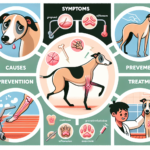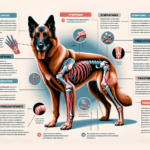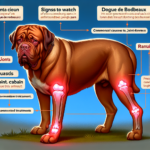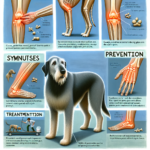Greyhound Joint Pain: Causes, Symptoms, Prevention, and Treatment

Introduction
Greyhounds are a unique and fascinating breed known for their incredible speed, grace, and gentle temperament. Originating from ancient Egypt, Greyhounds have a long history as hunting dogs and racing champions. Their sleek, aerodynamic bodies and powerful legs make them one of the fastest dog breeds, capable of reaching speeds up to 45 miles per hour. Despite their athletic prowess, Greyhounds are also known for their calm and affectionate nature, making them excellent companions.
Like all breeds, Greyhounds are susceptible to certain health issues. Among these, joint pain is a significant concern due to their unique physical structure and high activity levels. Joint health is crucial for Greyhounds, as it directly impacts their mobility, quality of life, and overall well-being.
Breed-Specific Joint Pain Risks
Genetic Predisposition
Greyhounds, like many other breeds, can be genetically predisposed to joint-related issues. Conditions such as hip dysplasia, arthritis, and elbow dysplasia are not uncommon. Hip dysplasia, in particular, is a hereditary condition where the hip joint does not fit properly into the hip socket, leading to pain and arthritis over time. While not all Greyhounds will develop these conditions, their genetic makeup can increase the risk.
Age-Related Risks
As Greyhounds age, the likelihood of developing joint pain increases. The wear and tear on their joints from years of activity can lead to conditions like osteoarthritis. Typically, signs of joint pain may start to appear in Greyhounds around the age of 6 to 8 years, although this can vary depending on the individual dog’s health and lifestyle.
Activity Level and Joint Stress
Greyhounds are known for their high energy levels and need for regular exercise. While this is beneficial for their overall health, it can also contribute to joint stress. The intense physical activity, especially in racing Greyhounds, can lead to microtraumas in the joints, which accumulate over time and result in chronic pain and inflammation.
Common Symptoms of Joint Pain in Greyhounds
General Symptoms
- Limping or favoring one leg
- Stiffness, especially after rest
- Reluctance to move, jump, or climb stairs
- Decreased activity or playfulness
- Visible discomfort or pain when touched
- Swelling around the joints
Breed-Specific Symptoms
In Greyhounds, joint pain may manifest in specific ways due to their unique body structure. For instance, you might notice a Greyhound having difficulty getting up from a lying position or showing a reluctance to run at their usual speed. Additionally, their thin skin and low body fat make any swelling or changes in the joints more noticeable.
When to Consult a Vet
If you observe any of the above symptoms in your Greyhound, it is essential to consult a veterinarian promptly. Early diagnosis and treatment can significantly improve the prognosis and quality of life for your dog. Persistent limping, noticeable pain, or any sudden changes in behavior should be addressed immediately.
Preventive Measures for Joint Health
Exercise Recommendations
Regular, moderate exercise is crucial for maintaining joint health in Greyhounds. Activities such as walking, swimming, and controlled running can help keep their joints flexible and muscles strong without causing excessive stress. Avoid high-impact activities like jumping or abrupt changes in direction, which can strain the joints.
Dietary Suggestions
A balanced diet rich in essential nutrients can support joint health. Consider incorporating foods or supplements that contain glucosamine, chondroitin, and omega-3 fatty acids, which are known to promote joint health and reduce inflammation. Always consult your veterinarian before adding any supplements to your dog’s diet.
Weight Management
Maintaining a healthy weight is vital for reducing joint stress in Greyhounds. Excess weight can exacerbate joint pain and lead to further complications. Monitor your dog’s weight regularly and adjust their diet and exercise routine as needed to keep them at an optimal weight.
Early Screening and Monitoring
Regular veterinary check-ups are essential for early detection of joint issues. Your vet may recommend specific screening tests, such as X-rays or joint fluid analysis, to identify any problems early on. Early intervention can help manage symptoms and slow the progression of joint diseases.
Treatment Options for Joint Pain
Non-Surgical Treatments
Non-surgical treatments for joint pain in Greyhounds include medications, physical therapy, and lifestyle adjustments. Anti-inflammatory drugs and pain relievers can help manage symptoms, while physical therapy can improve joint function and mobility. Lifestyle changes, such as providing a comfortable bed and avoiding slippery surfaces, can also make a significant difference.
Surgical Options
In severe cases, surgical intervention may be necessary. Procedures such as hip replacement, arthroscopy, or joint fusion can provide relief and improve mobility. The type of surgery will depend on the specific condition and the severity of the joint damage. Always discuss the risks and benefits with your veterinarian before proceeding with surgery.
Alternative Therapies
Alternative treatments like acupuncture, hydrotherapy, and massage can also benefit Greyhounds with joint pain. Acupuncture can help reduce pain and inflammation, while hydrotherapy provides low-impact exercise that strengthens muscles without stressing the joints. Massage therapy can improve circulation and relieve muscle tension.
Lifestyle and Management Tips
Daily Care Routine
A consistent daily care routine can help manage joint pain in Greyhounds. This might include gentle exercise, a balanced diet, and regular grooming to monitor for any changes in their condition. Providing a warm, comfortable place to rest and using ramps instead of stairs can also make a significant difference.
Modifying the Home Environment
Making your home more joint-friendly can help alleviate discomfort for your Greyhound. Consider using orthopedic beds to provide better support for their joints. Installing ramps or using non-slip mats can make it easier for them to move around without straining their joints.
Long-Term Management
Long-term management of joint pain involves regular veterinary check-ups, ongoing monitoring of symptoms, and adjustments to their care routine as needed. Keeping your Greyhound active and engaged with low-impact activities can help maintain their quality of life. Always consult your veterinarian for personalized advice and treatment plans.
FAQs About Greyhounds and Joint Pain
What are the early signs of joint pain in Greyhounds?
Early signs of joint pain in Greyhounds include limping, stiffness, reluctance to move, and decreased activity levels. If you notice any of these symptoms, consult your veterinarian for a thorough evaluation.
Can diet help prevent joint pain in Greyhounds?
Yes, a balanced diet rich in essential nutrients like glucosamine, chondroitin, and omega-3 fatty acids can support joint health and reduce inflammation. Always consult your veterinarian before making any dietary changes.
Are there specific exercises that are better for Greyhounds with joint pain?
Low-impact exercises such as walking, swimming, and controlled running are ideal for Greyhounds with joint pain. Avoid high-impact activities that can strain the joints.
When should I consider surgery for my Greyhound’s joint pain?
Surgery should be considered when non-surgical treatments are no longer effective, and your Greyhound’s quality of life is significantly impacted. Consult your veterinarian to discuss the best surgical options for your dog’s specific condition.
Can alternative therapies help manage joint pain in Greyhounds?
Yes, alternative therapies like acupuncture, hydrotherapy, and massage can provide relief and improve mobility for Greyhounds with joint pain. Always consult your veterinarian before starting any new treatment.
Conclusion
Joint pain is a common concern for Greyhounds, but with proper care and attention, it can be managed effectively. By understanding the causes, symptoms, and preventive measures, you can help ensure your Greyhound remains active and comfortable throughout their life. Regular veterinary check-ups, a balanced diet, appropriate exercise, and a supportive home environment are key to maintaining your Greyhound’s joint health. Always consult your veterinarian for personalized advice and treatment plans to keep your beloved pet happy and healthy.




